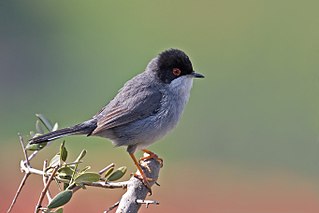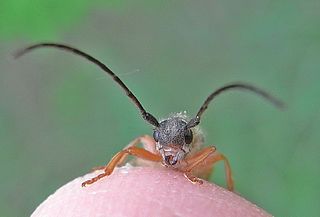Related Research Articles

The black turnstone is a species of small wading bird. It is one of two species of turnstone in the genus Arenaria the ruddy turnstone being the other. It is now classified in the sandpiper family, Scolopacidae, but was formerly sometimes placed in the plover family, Charadriidae. It is native to the west coast of North America and breeds only in Alaska.

The Sardinian warbler is a common and widespread typical warbler from the Mediterranean region. Like most Curruca species, it has distinct male and female plumages. The adult male has a grey back, whitish underparts, black head, white throat and red eyes. Plumages are somewhat variable even in the same locality, with the intensity of a reddish hue on upper- and/or underside varies from absent to pronounced. The female is mainly brown above and buff below, with a grey head. The Sardinian warbler's song is fast and rattling, and is very characteristic of the Mediterranean areas where this bird breeds.

The black-headed heron is a wading bird of the heron family Ardeidae, common throughout much of sub-Saharan Africa and Madagascar. It is mainly resident, but some west African birds move further north in the rainy season.

The black-headed bunting is a passerine bird in the bunting family Emberizidae. It breeds in south-east Europe east to Iran and migrates in winter mainly to India, with some individuals moving further into south-east Asia. Like others in its family, it is found in open grassland habitats where they fly in flocks in search of grains and seed. Adult males are well marked with yellow underparts, chestnut back and a black head. Adult females in breeding plumage look like duller males. In other plumages, they can be hard to separate from the closely related red-headed bunting and natural hybridization occurs between the two species in the zone of overlap of their breeding ranges in northern Iran.

The New Zealand bellbird, also known by its Māori names korimako and makomako, is a passerine bird endemic to New Zealand. It has greenish colouration and is the only living member of the genus Anthornis. The bellbird forms a significant component of the famed New Zealand dawn chorus of bird song that was much noted by early European settlers. The explorer Captain Cook wrote of its song "it seemed to be like small bells most exquisitely tuned". Its bell-like song is sometimes confused with that of the tui. The species is common across much of New Zealand and its offshore islands as well as the Auckland Islands.

Tantilla melanocephala, commonly known as the black-headed snake, is a species of small colubrid snake endemic to Central America and South America.

Puccinia melanocephala is a plant pathogen, it is the causal agent of sugarcane rust. This pathogen affects multiple species of sugarcane, including Saccharum spontaneum or wild sugarcane, Saccharum robustum, and the most commonly cultivated species Saccharum officinarum. Puccinia melanocephala can also infect other member of the family Poaceae, including some species of bamboo such as Bambusa vulgaris. The first symptoms of sugarcane rust are elongate, yellow-colored leaf spots, roughly 1mm to 4mm in length. The leaf spots gradually become bigger and turn a reddish-brown color. The uredia develop underneath the epidermis where the leaf spots are present. When the uredia become big enough, they break through the epidermis to form the characteristic rust pustules from which uredospores are borne. These pustules can coalesce, resulting in large areas of dead tissue.

The Arabian partridge is a species of bird in the family Phasianidae, native to the southern Arabian peninsula. Two subspecies are recognised, A. m. melanocephala and A. m. guichardi. It sometimes hybridises with Philby's partridge and with the rock partridge.

The black-headed berryeater is a species of bird in the family Cotingidae. It is endemic to Brazil.

The black-throated barbet is a species of bird in the Lybiidae family. It is found in Djibouti, Eritrea, Ethiopia, Kenya, Somalia, South Sudan, Tanzania, and Uganda.

Lachesis melanocephala is a venomous pit viper species found in Costa Rica. No subspecies are currently recognized.

Oberea is a genus of longhorn beetles, most of which are stem borers of various plants, including blackberries and their relatives.
Melanocephalus is an epithet often used as the second word of a binomial name. It derives from Greek words meaning 'black-headed'. It is used in the names of the following species:
Oberea consentanea is a species of beetle in the family Cerambycidae. It was described by Francis Polkinghorne Pascoe in 1867. It is known from Borneo.
Oberea rubetra is a species of beetle in the family Cerambycidae. It was described by Francis Polkinghorne Pascoe in 1858. It is known from Sumatra, Borneo and Malaysia.
Oberea erythrostoma is a species of beetle in the family Cerambycidae. It was described by Heller in 1915. It is known from the Philippines.

Oberea euphorbiae is a species of beetle in the family Cerambycidae. It was described by Ernst Friedrich Germar in 1813 originally under the genus Saperda. It has a wide distribution in Europe. It feeds on Euphorbia palustris.
Oberea ferruginea is a species of beetle in the family Cerambycidae. It was described by Thunberg in 1787.
References
- ↑ BioLib.cz - Oberea melanocephala. Retrieved on 8 September 2014.